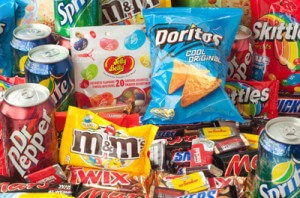Junk Food – What’s so Trashy?

“Junk foods” tend to be a way of life for today’s on-the-go society, whether it is a quick snack or a fast food meal. Eating while driving or watching television is a common pastime. In both cases, people are distracted and tend not to pay attention to portion sizes or ingredients.
The main concerns about so called junk foods (such as chips, candy bars, French fries, and other fast food items) is that they contain a high percentage of preservatives and additives, tend to be high in fat and sodium, and have little or no nutritional value.
Junk food is apt to contain higher amounts of preservatives and additives for a variety of reasons—to achieve a certain taste or color, or to give a product a longer shelf life. Although food additives are approved by the Federal Food and Drug Administration, this does not mean that they are good for you—as proven by the FDA’s ongoing research and changing recommendations.
For example, the artificial sweetener saccharin once carried a food warning label because it was found to cause cancer in laboratory animals. That warning was rescinded in 2000, but saccharin’s use had already diminished. The artificial fat substitute Olestra debuted in the 1990s. FDA-approved, it was manufactured in chips and ice cream, but lost popularity because of its side-effects that included cramping and loose stools. Some U.S. products still contain Olestra, but its use is banned in Canada.
“Generally, junk foods are processed products. Their natural nutrition as nature intended has been altered and may no longer be available to the body for various metabolic needs, thus also effecting overall health,” said registered dietitian Debbi Beauvais, a spokesperson for the American Dietetic Association.
Be aware of nutrition labels and ingredients and practice moderation. Treating yourself to a serving of potato chips (1 ounce) is not unhealthy when balanced with recommended amounts of fruits, vegetables and proteins. “When it comes to fun foods we crave, you have to be mindful of what you are eating and how much,” Beauvais said. One serving of potato chips (about 1 ounce/15 chips) contains roughly 10 grams of fat (10 percent your recommended daily allowance). The snack size bag of chips usually contains more than two servings, so you can easily push those numbers to an unhealthy level if you do not pay attention to portion size.
Educate yourself by keeping up with the latest studies and government findings. Recently, a Harvard University School of Public Health study found that regular consumption of processed meats, like hot dogs and cold cuts, increases the risk of diabetes by as much as 50 percent. When you have a craving, try to select junk foods with the least amount of fat, sodium and preservatives. If your body could say “thank you,” it would!

